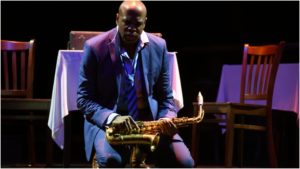
Arizona Opera 2018-19 Review: Charlie Parker’s Yardbird
A Solid Rendition Of A Work That Needs To Be Heard More Often
By Maria Nockin“Charlie Parker’s Yardbird” features music by saxophone virtuoso Daniel Schnyder and a libretto by playwright Bridgette A. Wimberly. Since it premiered in 2015 at Opera Philadelphia, several the work has premiered with a number of companies, including the Lyric Opera of Chicago and the English National Opera. Perhaps the most interesting locale for “Yardbird” was its presentation at Harlem’s Apollo Theatre in 2016.
Arizona Opera’s production, performed on November 9, 2018, was the first seen west of the Rockies.
The opera’s score calls for six singers: two men and four women, who are accompanied by a 15-piece orchestra that plays a plethora of musical styles. Of course, the score includes a considerable amount of jazz and the music for which Charlie Parker and Dizzy Gillespie were famous, bebop. A fast and lively style of jazz, bebop features complex chord progressions and numerous key changes. It calls for instrumental virtuosity and intellectually satisfying improvisation.
Venturing Into the Work
Wimberly’s libretto tells Parker’s story in 21 surrealistic flashback scenes that take place beginning with his death from an overdose of heroine in the hotel room of his frightened patron, “Nica.” Actually the Baroness Pannonica de Koenigswarter, Nica was evicted from her hotel suite when it was discovered that Parker had died there. Mark Halpin’s settings reflected the spirit of each scene with the help of Greg Emetaz’s projections. Bottles on ceiling-high shelves morphed into live birds and returned to their original form while other aspects of Birdland, the nightclub named after Parker, rekindled long-dead embers in the hearts of aged jazz lovers.
Ce Ce Sickler’s costumes put the action in the middle of the last century when much of this country was segregated and a black man, no matter what his profession, could not rent a room in a good hotel. Parker’s mother wore a dress suitable for Sunday church. Wives Rebecca and Doris wore simple daytime ensembles while Chan wore a short evening gown. Sickler clothed Charlie and Dizzy in outfits similar to those seen in their pictures.
The opera’s scenes were not always in strict linear order, but they reflected the disarray of Parker’s life. With the singing and acting of Joshua Stewart and direction by Fenlon Lamb, the audience came to understand not only Parker’s talent, but also his personality, his place in mid-twentieth century society, and the pain that caused him to seek solace in drugs and alcohol. Singing in fluent bel canto as well as jazz styles, Stewart’s Parker was an ardent lover who reserved his greatest passion for music.
Parker & Company
Composer Schnyder, librettist Wimberly, and director Lamb created memorable characters in their portraits of Parker and his mother. Sung by Karin Slack, Addie’s powerful personality reminded me of strong-willed mothers I have known as a teacher. With warm and inviting mezzo-soprano tones, she sang fervently of raising a black man-child in a world that didn’t always acknowledge the extent of his talent. Thus, she showed a picture of segregated life in the 1950s to 21st century operagoers.
Dramatically less individually distinguishable, Parker’s wives showed his choices were similar. Mezzo Chrystal E. Williams, the only artist who sang in the Philadelphia premiere and the Phoenix production, was a knowing Rebecca. As the first Mrs. Charlie Parker, she sang with a sultry sound as she proved she knew all of her husband’s tricks. Soprano Kaitlyn Johnson was an energetic Doris who charmed Parker with her sweet lyric tones. Fellow soprano Cadie Jordan was Chan, a free spirit who emoted with silver high notes. If Schnyder, Wimberly, and Lamb intended to show their commonality as well as their beauty, they succeeded.
Nica, played by creamy-toned mezzo Stephanie Sanchez, stood out among Charlie’s wives and girlfriends because she was older and flaunted her independence. Baritone Sidney Outlaw was a recognizable Dizzy Gillespie wearing the expected beret and glasses. He sang with powerful low notes that added intense harmony to the ensembles. Dizzy understood Charlie in a way that few others could because he had similar likes and desires. Dramatically and musically each reflected the other’s personality in a way that strengthened both characterizations.
Tighter Package?
I wonder if the drama would have been a tighter package if every scene was a perfect reenactment of a time in Parker’s life. That might give us more information, but I think the opera’s mode of presentation let the audience feel the beat and hear the occasional harmony along with the overreaching dissonance of Parker’s life. Music often touches us in a way words cannot and, for me, Maestro Clinton Smith’s rendition of Schnyder’s score went straight to the heart. His ensemble played every style and every layer of intense harmonic color with graceful fluidity.
After the show, Arizona Opera presented a “Talk Back” with Director of Community Engagement Kyle Homewood interviewing Composer and Jazz Saxophonist Daniel Schnyder and Librettist Bridgette A. Wimberly about their work on the opera. It was a fascinating way of allowing the audience to gain more knowledge about this important addition to the operatic repertoire.
New in this production was the choreography and dance of Du’Bois A’Keen. Shadowing and interpreting Charlie Parker’s thoughts and words, A’Keen’s graceful and compelling movement may have actually represented the saxophonists’s true love, music. Both composer and librettist approved this addition to the production.
“Charlie Parker’s Yardbird” definitely deserves to be heard more than once. I know it will be in Seattle soon, but I am hoping to hear it in the Los Angeles area as well. This work is a fascinating excursion into the possibilities of opera as a living, breathing art.


